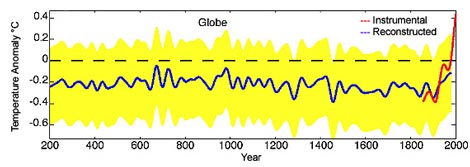Reference
Mann, M.E. and Jones, P.D. 2003. Global surface temperatures over the past two millennia. Geophysical Research Letters 30: 10.1029/2003GL017814.
What was done
Using 23 individual proxy records from 8 distinct regions in the Northern Hemisphere and 5 proxy records from the Southern Hemisphere, the authors constructed Northern and Southern Hemispheric and global mean temperature histories over the period AD 200 to as close as they could get to the present employing a 40-year lowpass filter of the data.
What was learned
Mann and Jones say their temperature reconstructions indicate that "late 20th century warmth is unprecedented for at least roughly the past two millennia for the Northern Hemisphere." They also say their data and analysis "suggest a similar, but less definitive conclusion, for the global mean."
Although we and many others have many bones to pick with many aspects of Mann and Jones' analysis, we will here focus on just a couple of points and temporarily grant them the benefit of the doubt in those other areas.
First of all, granting them almost everything they have done, it can readily be seen from their own graph of their own results that the end point of their reconstructed global mean temperature history is not the warmest period of the prior 1800 years. In fact, their treatment of the data depicts three earlier warmer periods: one just prior to AD 700, one just after AD 700 and one just prior to AD 1000 (see figure below).

The globe only becomes warmer in the 20th century when its measured temperatures are substituted for its reconstructed temperatures. This approach is clearly unacceptable; it is like comparing apples and oranges. If one has only reconstructed temperatures from the distant past, one can only validly compare them with reconstructed temperatures from the recent past.
It is of course true that Mann and Jones' reconstructed Northern Hemisphere mean temperature is warmer at the end of their record than at any earlier time. However, as they say with respect to what they call the "flawed recent study" of Soon and Baliunas (2003), it is "essential (e.g., by compositing records) to distinguish between regional anomalies, which often cancel in a hemispheric mean." So too is it necessary to distinguish between hemispheric anomalies that may cancel - or augment - each other in the global mean, which is, after all, what we are talking about here, i.e., global warming, as even Mann and Jones indicate in the title of their paper. Hence, when all of the pertinent data are considered (as sparse as they may be for certain regions of the globe), i.e., when the Northern and Southern Hemispheric reconstructed temperature histories of Mann and Jones are composited, the temperature history most appropriate to the theory of global warming (their reconstructed global mean temperature history) fails to support the thesis that the planet is currently warmer than it has been at any other time over the prior two millennia.
Another important point that is ignored by Mann and Jones is that the last century witnessed a dramatic increase in atmospheric CO2 concentration, which everyone knows is an effective aerial fertilizer. It also witnessed a dramatic increase in atmospheric nitrogen deposition, which further enhances plant growth. Consequently, as tree-ring data comprise the bulk of the proxy temperature information employed by Mann and Jones, their reconstructed global mean temperature history must possess a non-temperature-induced pseudo-warming signal driven by CO2- and nitrogen-induced increases in growth that make 20th century warming appear significantly greater than it really is. Hence, there could well be still other periods of the past 1800 years (in addition to the three we have already noted) when the global mean temperature was also warmer than it was at the end of their reconstructed record in the 20th century; and when properly accounted for, this phenomenon may result in this being the case for the Northern Hemisphere as well.
What it means
Mann and Jones have clearly failed to demonstrate the key point they desired to make in their paper. Their data, however, speak for themselves in clearly demonstrating that late 20th century global warmth was not unprecedented over the past two millennia.
Reference
Soon, W. and Baliunas, S. 2003. Proxy climatic and environmental changes of the past 1000 years. Climate Research 23: 89-110.
Reviewed 20 August 2003




